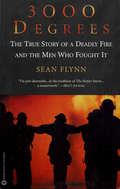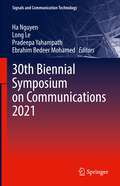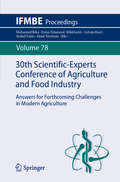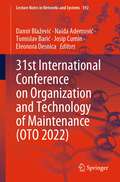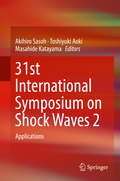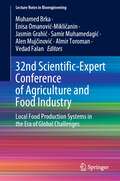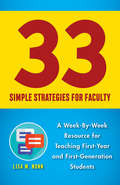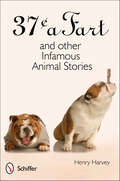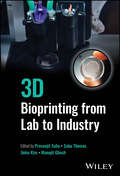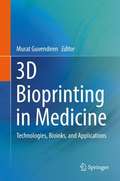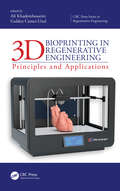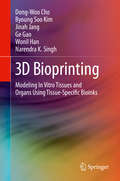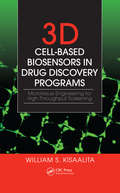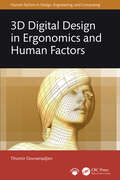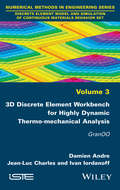- Table View
- List View
3000 Degrees: The True Story of a Deadly Fire and the Men Who Fought It
by Sean FlynnOn December 3, 1999, the call came in to the men of the Worcester, Massachusetts, Fire Department: a five-alarm blaze in a six-story, abandoned, windlowless warehouse filled with lethal hallways and meat lockers. Once inside, they found themselves trapped in a snarling furnace as hot as a crematorium, with smoke so black and predatory they had to feel for their partners next to them. Swallowed deep inside the building, with no way out, they trusted their mates to do their jobs, valiantly struggling to survive an ill-fated ordeal that would push them to the very limits of loyalty and courage. 3000 DEGREES is the gripping account of heroic men whose job it is to rush into burning buildings-when everyone else just wants out.
30th Biennial Symposium on Communications 2021 (Signals and Communication Technology)
by Ha Nguyen Long Le Pradeepa Yahampath Ebrahim Bedeer MohamedThe book presents the proceedings of the 30th Biennial Symposium on Communications 2021 (BSC21), a prestigious international research conference in communications, information theory, and signal processing. Started in 1962 by Queen’s University, Canada, the Symposium is now presented by the Canadian Society of Information Theory. Its 30th edition was hosted virtually by The University of Saskatchewan and held in Saskatoon from June 28 to 30, 2021. Topics include Communication and Information Theory, Coding and Signal Processing for Communications, and Multiple Antenna Systems and Cooperative Communications.
30th International Conference on Organization and Technology of Maintenance: Proceedings of 30th International Conference on Organization and Technology of Maintenance (OTO 2021) (Lecture Notes in Networks and Systems #369)
by Samir Avdaković Naida Ademović Hrvoje Glavaš Marijana Hadzima-Nyarko Mirko KarakašićThis book promotes an interdisciplinary approach to maintenance, through the presentation of practical and theoretical research in the field of electrical, civil, and mechanical engineering. The goal is to raise the level of maintenance knowledge, taking into account the continuous advancement of engineering and technology in all spheres of economy, infrastructure, and public services. This book contains papers presented at the 30th International Conference on Organization and Technology of Maintenance (OTO 2021), and the conference was held on Josip Juraj Strossmayer University of Osijek, Faculty of Electrical Engineering, Computer Science and Information Technology Osijek on 10-11 December 2021. The book brings 36 original papers written by authors from ten countries that underwent a blind review process by the international review board members. The conference covers the topics as organization and management of maintenance, maintenance technologies, quality management in system maintenance, information systems in maintenance, product lifecycle management, design for maintainability, material and structure properties, reliability of technical systems and environmental safety, diagnosis and prognosis of failures and operational malfunctions, design optimization for maintenance, maintenance in technical systems, analysis of efficiency and cost effectiveness of maintenance, influence of maintenance on the environment and employee safety, maintenance legislation, and education for maintenance. The papers presented in the book reflect the current state of approach to maintenance as an interdisciplinary field. The OTO conference proved itself as an ideal opportunity for communication between scientists and experts in maintenance practice with the aim to raise the level of expertise and introduce new methods and maintenance procedures into everyday practice.
30th Scientific-Experts Conference of Agriculture and Food Industry: Answers for Forthcoming Challenges in Modern Agriculture (IFMBE Proceedings #78)
by Enisa Omanović-Mikličanin Muhamed Brka Lutvija Karić Vedad Falan Almir ToromanThis book gathers the proceedings of the 30th Scientific-Experts Conference of Agriculture and Food Industry, held on September 26-27, 2019, in Sarajevo, Bosnia and Herzegovina. It reports on the application of innovative technologies in food sciences and agriculture, and covers research in plant and animal production, agricultural economics and food production. Further, the book discusses key social and environmental issues, and proposes answers to current challenges. The conference was jointly organized by the Faculty of Agriculture and Food Sciences of the University of Sarajevo, Bosnia and Herzegovina, the Faculty of Agriculture of Ege University, Turkey, the Bosnia and Herzegovina Medical and Biological Engineering Society, and the Faculty of Agriculture of the University of Belgrade, Serbia. The proceedings offer a timely snapshot of cutting-edge, multidisciplinary research and developments in modern agriculture. As such, they address the needs of researchers and professionals, agricultural companies, food producers, and regulatory and food safety agencies.
31st International Conference on Organization and Technology of Maintenance (Lecture Notes in Networks and Systems #592)
by Naida Ademović Damir Blažević Tomislav Barić Josip Cumin Eleonora DesnicaThe book promotes an interdisciplinary approach to maintenance, through the presentation of practical and theoretical research in the field of electrical, civil, and mechanical engineering. The goal is to raise the level of maintenance knowledge, taking into account the continuous advancement of engineering and technology in all spheres of economy, infrastructure, and public services. This book contains papers presented at the 31st International Conference on Organization and Technology of Maintenance (OTO 2022), held at Josip Juraj Strossmayer University of Osijek, Faculty of Electrical Engineering, Computer Science and Information Technology Osijek, on December 12, 2022. The book brings 19 original papers written by authors from seven countries that underwent a blind review process by international review board members. The conference covers various topics like maintenance in technical systems, reliability of technical systems, design for maintainability, maintenance in agriculture, maintenance of machine elements, maintenance in the power systems, design optimization for maintenance, influence of maintenance on the environment, employee safety, maintenance and artificial intelligence, maintenance, and the new product design. The papers presented in the book reflect the current state of approach to maintenance as an interdisciplinary field. The OTO conference proved itself as an ideal opportunity for communication between scientists and experts in maintenance practice with the aim to raise the level of expertise and introduce new methods and maintenance procedures into everyday practice.
31st International Symposium on Shock Waves 2: Applications
by Akihiro Sasoh Toshiyuki Aoki Masahide KatayamaThis is the second volume of a two volume set which presents the results of the 31st International Symposium on Shock Waves (ISSW31), held in Nagoya, Japan in 2017. It was organized with support from the International Shock Wave Institute (ISWI), Shock Wave Research Society of Japan, School of Engineering of Nagoya University, and other societies, organizations, governments and industry. The ISSW31 focused on the following areas: Blast waves, chemical reacting flows, chemical kinetics, detonation and combustion, ignition, facilities, diagnostics, flow visualization, spectroscopy, numerical methods, shock waves in rarefied flows, shock waves in dense gases, shock waves in liquids, shock waves in solids, impact and compaction, supersonic jet, multiphase flow, plasmas, magnetohyrdrodynamics, propulsion, shock waves in internal flows, pseudo-shock wave and shock train, nozzle flow, re-entry gasdynamics, shock waves in space, Richtmyer-Meshkov instability, shock/boundary layer interaction, shock/vortex interaction, shock wave reflection/interaction, shock wave interaction with dusty media, shock wave interaction with granular media, shock wave interaction with porous media, shock wave interaction with obstacles, supersonic and hypersonic flows, sonic boom, shock wave focusing, safety against shock loading, shock waves for material processing, shock-like phenomena, and shock wave education. These proceedings contain the papers presented at the symposium and serve as a reference for the participants of the ISSW 31 and individuals interested in these fields.
32nd International Conference on Organization and Technology of Maintenance (Lecture Notes in Networks and Systems #866)
by Naida Ademović Eleonora Desnica Tomislav Keser Ivan GrgićThis book presents papers submitted at 32nd International Conference on Organization and Technology of Maintenance (OTO 2023) held on December 12, 2023, at Osijek, Republic of Croatia. The objective of this conference is to promote, standardize, and support efforts to gain new knowledge in areas that are intimately tied to technical and social systems and where maintenance of any kind is of utmost importance. By bringing together experts from various fields, this conference aims to foster collaboration and the exchange of ideas, ultimately leading to advancements in both technical and social systems. Additionally, it seeks to create a platform for discussing best practices and innovative approaches in maintenance, ensuring the sustainability and efficiency of these systems in the long run. Furthermore, the upkeep of technological and social systems, along with their accessibility and dependability, significantly influences the long-term sustainability and economic feasibility of their functioning. Periodic and condition-based maintenance are integral components of the various systems, influencing their operational efforts and outcomes. By providing a space for professionals to exchange ideas and experiences, this platform facilitates the identification and implementation of cutting-edge maintenance strategies. Moreover, it recognizes the importance of addressing emerging challenges such as digitalization and environmental impact in order to ensure the continued effectiveness of these systems. Conference topics will address maintenance challenges in the areas of machine design, maintenance technologies in general, organization and management of maintenance proposals and procedures, quality management in system maintenance, information systems, product life cycle management, design for maintainability, material and structural properties, diagnosis and prediction of failures and breakdowns, design optimization for maintenance, analysis of maintenance efficiency and cost-effectiveness, civil, mechanical and electrical engineering, etc.
32nd Scientific-Expert Conference of Agriculture and Food Industry: Local Food Production Systems in the Era of Global Challenges (Lecture Notes in Bioengineering)
by Enisa Omanović-Mikličanin Muhamed Brka Vedad Falan Almir Toroman Alen Mujčinović Jasmin Grahić Samir MuhamedagićThis book gathers the proceedings of the 32nd Scientific-Experts Conference of Agriculture and Food Industry, held on December 1-2, 2022, in Sarajevo, Bosnia and Herzegovina. It reports on the application of molecular, nano- and engineering technologies for food sciences, and plant and animal production. It discusses important agricultural economics and social and environmental issues, proposings some answers to current and future challenges. The chapters reflect the special focus of this conference edition, which was on discussing strategies for developing a more resilient and sustainable agrifood systems. Offering a timely snapshot of cutting-edge and multidisciplinary research and methods, this book addresses researchers, professionals, and stakeholders in the broad field of agriculture and food sciences, biotechnology, and bio- and nanoengineering.
33 Men: Inside the Miraculous Survival and Dramatic Rescue of the Chilean Miners
by Jonathan Franklin<p>Having had unparalleled access to the Chilean mine disaster, award-winning journalist Jonathan Franklin takes readers to the heart of a remarkable story of human endurance, survival, and historic heroism. <p><i>33 Men</i> is the groundbreaking, authoritative account of the Chilean mine disaster, one of the longest human entrapments in history. Rushing to the scene when the miners were discovered, Franklin obtained a coveted "Rescue Team" pass and reported directly from the front lines of the rescue operation, beyond police controls, for six weeks. Based on more than 110 intimate interviews with the miners, their families, and the rescue team, Franklin's narrative captures the remarkable story of these men and women, in details shocking, beautiful, comedic, and heroic. <p>Gripping and raw with never-before-revealed details, <i>33</i> Men is a true story that reads like a thriller.</p>
33 Simple Strategies for Faculty: A Week-By-Week Resource for Teaching First-Year and First-Generation Students
by Lisa M. NunnMany students struggle with the transition from high school to university life. This is especially true of first-generation college students, who are often unfamiliar with the norms and expectations of academia. College professors usually want to help, but many feel overwhelmed by the prospect of making extra time in their already hectic schedules to meet with these struggling students. 33 Simple Strategies for Faculty is a guidebook filled with practical solutions to this problem. It gives college faculty concrete exercises and tools they can use both inside and outside of the classroom to effectively bolster the academic success and wellbeing of their students. To devise these strategies, educational sociologist Lisa M. Nunn talked with a variety of first-year college students, learning what they find baffling and frustrating about their classes, as well as what they love about their professors’ teaching. Combining student perspectives with the latest research on bridging the academic achievement gap, she shows how professors can make a difference by spending as little as fifteen minutes a week helping their students acculturate to college life. Whether you are a new faculty member or a tenured professor, you are sure to find 33 Simple Strategies for Faculty to be an invaluable resource.
33rd International Conference on Organization and Technology of Maintenance (Lecture Notes in Networks and Systems #1242)
by Naida Ademović Hrvoje Glavaš Marijana Hadzima-Nyarko Tomáš HanákThis book offers a comprehensive and innovative exploration of maintenance technologies, blending fundamental theories with practical applications in modern engineering systems. Covering a broad range of topics, it examines areas such as smart street lighting for energy conservation, the effects of faulty power supplies on equipment, and the use of digital twin technology in concrete plant operations. Emerging and unique subjects, such as utilizing unused faculty computers for cryptocurrency mining and employing augmented reality for maintenance scheduling, underscore innovative approaches. Targeted at engineers, maintenance professionals, researchers, and students, the book provides valuable insights for enhancing asset reliability, operational efficiency, and safety protocols across various industries. The collected contributions emphasize the interdisciplinary nature of maintenance and serve as a platform for exchanging expertise and introducing innovative methods into daily practice.
37 Cents a Fart and other Infamous Animal Stories
by Henry HarveyTrue, entertaining stories about real animals accompanied by 60 charming illustrations40+ vignettes about charismatic, humorous, and genius members of the animal kingdomA page turner with funny (sometimes adult funny) twists
39 Ways to Save the Planet
by Tom HeapWe got ourselves into this. Here's how we can get ourselves out.We know the problem: the amount of biodiversity loss, the scale of waste and pollution, the amount of greenhouse gas we pump into the air... it's unsustainable. We have to do something. And we are resourceful, adaptable and smart. We have already devised many ways to reduce climate change - some now proven, others encouraging and craving uptake. Each one is a solution to get behind.In 39 Ways to Save the Planet, Tom Heap reveals some of the real-world solutions to climate change that are happening around the world, right now. From tiny rice seeds and fossil fuel free steel to grazing elk and carbon-capturing seagrass meadows, each chapter reveals the energy and optimism in those tackling the fundamental problem of our age. Accompanying a major BBC Radio 4 series in collaboration with the Royal Geographical Society, 39 Ways to Save the Planet is a fascinating exploration of our attempt to build a better future, one solution at a time. A roadmap to global action on climate change, it will encourage you to add your own solutions to the list.
3D Biometrics: Systems and Applications
by David Zhang Guangming LuAutomatic personal authentication using biometric information is becoming more essential in applications of public security, access control, forensics, banking, etc. Many kinds of biometric authentication techniques have been developed based on different biometric characteristics. However, most of the physical biometric recognition techniques are based on two dimensional (2D) images, despite the fact that human characteristics are three dimensional (3D) surfaces. Recently, 3D techniques have been applied to biometric applications such as 3D face, 3D palmprint, 3D fingerprint, and 3D ear recognition. This book introduces four typical 3D imaging methods, and presents some case studies in the field of 3D biometrics. This book also includes many efficient 3D feature extraction, matching, and fusion algorithms. These 3D imaging methods and their applications are given as follows: - Single view imaging with line structured-light: 3D ear identification - Single view imaging with multi-line structured-light: 3D palmprint authentication - Single view imaging using only 3D camera: 3D hand verification - Multi-view imaging: 3D fingerprint recognition 3D Biometrics: Systems and Applications is a comprehensive introduction to both theoretical issues and practical implementation in 3D biometric authentication. It will serve as a textbook or as a useful reference for graduate students and researchers in the fields of computer science, electrical engineering, systems science, and information technology. Researchers and practitioners in industry and R&D laboratories working on security system design, biometrics, immigration, law enforcement, control, and pattern recognition will also find much of interest in this book.
3D Bioprinting from Lab to Industry
by Sabu Thomas Prosenjit Saha Jinku Kim Manojit GhoshA complete overview of bioprinting, from fundamentals and essential topics to recent advances and future applications Additive manufacturing, also known as 3D printing, is one of the most transformative technological processes to emerge in recent decades. Its layer-by-layer construction method can create objects to remarkably precise specifications with minimal waste or energy consumption. Bioprinting, a related process that employs cells and biomaterials instead of man-made substances or industrial materials, has a range of biomedical and chemical uses that make it an exciting and fast-growing area of research. 3D Bioprinting from Lab to Industry offers a cutting-edge overview of this topic, its recent advances, and its future applications. Taking an interdisciplinary approach to a flourishing research field, this book exceeds all existing treatments of the subject in its scope and comprehensiveness. Moving from fundamental principles of the technology to its immense future potential, this is a must-own volume for scientists looking to incorporate this process into their research or product development. 3D Bioprinting from Lab to Industry readers will also find: Treatment of printing parameters, surface topography requirements, and much more Detailed discussion of topics including 5D printing in the medical field, dynamic tuning, the multi-material extrusion approach, and many others A complete account of the bioprinting process, from lab requirements to commercialization 3D Bioprinting from Lab to Industry is ideal for researchers—graduate and post-doctoral scholars—in the areas of materials science, biomedical engineering, chemical engineering, biotechnology, and biochemistry.
3D Bioprinting in Medicine: Technologies, Bioinks, and Applications
by Murat GuvendirenThis book provides current and emerging developments in bioprinting with respect to bioprinting technologies, bioinks, applications, and regulatory pathways. Topics covered include 3D bioprinting technologies, materials such as bioinks and bioink design, applications of bioprinting complex tissues, tissue and disease models, vasculature, and musculoskeletal tissue. The final chapter is devoted to clinical applications of bioprinting, including the safety, ethical, and regulatory aspects. This book serves as a go-to reference on bioprinting and is ideal for students, researchers and professionals, including those in academia, government, the medical industry, and healthcare.
3D Bioprinting in Regenerative Engineering: Principles and Applications (CRC Press Series In Regenerative Engineering)
by Ali Khademhosseini Gulden Camci-UnalRegenerative engineering is the convergence of developmental biology, stem cell science and engineering, materials science, and clinical translation to provide tissue patches or constructs for diseased or damaged organs. Various methods have been introduced to create tissue constructs with clinically relevant dimensions. Among such methods, 3D bioprinting provides the versatility, speed and control over location and dimensions of the deposited structures. Three-dimensional bioprinting has leveraged the momentum in printing and tissue engineering technologies and has emerged as a versatile method of fabricating tissue blocks and patches. The flexibility of the system lies in the fact that numerous biomaterials encapsulated with living cells can be printed. This book contains an extensive collection of papers by world-renowned experts in 3D bioprinting. In addition to providing entry-level knowledge about bioprinting, the authors delve into the latest advances in this technology. Furthermore, details are included about the different technologies used in bioprinting. In addition to the equipment for bioprinting, the book also describes the different biomaterials and cells used in these approaches. This text: Presents the principles and applications of bioprinting Discusses bioinks for 3D printing Explores applications of extrusion bioprinting, including past, present, and future challenges Includes discussion on 4D Bioprinting in terms of mechanisms and applications
3D Bioprinting: Modeling In Vitro Tissues and Organs Using Tissue-Specific Bioinks
by Ge Gao Dong-Woo Cho Byoung Soo Kim Jinah Jang Wonil Han Narendra K. SinghThis text advances fundamental knowledge in modeling in vitro tissues/organs as an alternative to 2D cell culture and animal testing. Prior to engineering in vitro tissues/organs,the descriptions of prerequisites (from pre-processing to post-processing) in modeling in vitro tissues/organs are discussed. The most prevalent technologies that have been widely used for establishing the in vitro tissue/organ models are also described, including transwell, cell spheroids/sheets, organoids, and microfluidic-based chips. In particular, the authors focus on 3D bioprinting in vitro tissue/organ models using tissue-specific bioinks. Several representative bioprinting methods and conventional bioinks are introduced. As a bioink source, decellularized extracellular matrix (dECM) are importantly covered, including decellularization methods, evaluation methods for demonstrating successful decellularization, and material safety. Taken together, the authors delineate various application examples of 3D bioprinted in vitro tissue/organ models especially using dECM bioinks.
3D CAD with Autodesk 123D: Designing for 3D Printing, Laser Cutting, and Personal Fabrication
by Emily Gertz Jesse Harrington AuIf you've arrived at a stage in your creative life where you're ready to do more with your computer, it's time to learn how to combine its power with new advances in computer-aided design (CAD) and fabrication to make something awesome--in three dimensions! The free suite of Autodesk 123D software offers all the tools you need to capture or design three-dimensional objects and characters. This book tells you how to harness that power to print or fabricate just about anything you can imagine. Want to make something mechanical or structural that's based on precise measurements? 123D Design can help! Ready to create something cool based on a character, an organic shape, or something found in nature? 123D Catch, 123D Meshmixer, and 123D Sculpt+ will assist. Learn how to use these tools, plus 123D Make--perfect for prototyping designs you'll cut with a CNC mill--to take your creativity to a new level.An ideal book for Makers, hobbyists, students, artists, and designers (including beginners!), this book opens up the inexpensive world of personal fabrication to everyone.In 3D CAD with Autodesk 123D, you’ll:Meet the classic "Stanford bunny" and learn to modify it with MeshmixerScan and 3D print anything around youDesign your own 3D-printed guitarFind models in the Sculpt+ community and make a skeleton!Build a birdhouse, prototype a playground, or create a statueLearn everything from basics to troubleshooting skillsGet started making right away
3D Cadastre in an International Context: Legal, Organizational, and Technological Aspects
by Peter van Oosterom Jantien E. StoterThe increase in private property value, growth of underground and multilevel development, and the emergence of 3D technologies in planning and GIS drives the need to record 3D situations in cadastral registration. 3D Cadastre in an International Context: Legal, Organizational, and Technological Aspects demonstrates how to record 3D scenarios in ord
3D Cell Culture: Fundamentals and Applications in Tissue Engineering and Regenerative Medicine
by Ranjna C. Dutta Aroop K. Dutta3D cell culture is yet to be adopted and exploited to its full potential. It promises to upgrade and bring our understanding about human physiology to the highest level with the scope of applying the knowledge for better diagnosis as well as therapeutics. The focus of this book is on the direct impact of novel technologies and their evolution into viable products for the benefit of human race. It also describes the fundamentals of cell microenvironment to bring forth the relevance of 3D cell culture in tissue engineering and regenerative medicine. It discusses the extracellular matrix/microenvironment (ECM) and emphasizes its significance for growing cells in 3D to accomplish physiologically viable cell mass/tissue ex vivo. The book bridges the knowledge gaps between medical need and the technological applications through illustrations. It discusses the available models for 3D cell culture as well as the techniques to create substrates and scaffolds for achieving desired 3D microenvironment.
3D Cell-Based Biosensors in Drug Discovery Programs: Microtissue Engineering for High Throughput Screening
by William S. KisaalitaAdvances in genomics and combinatorial chemistry during the past two decades inspired innovative technologies and changes in the discovery and pre-clinical development paradigm with the goal of accelerating the process of bringing therapeutic drugs to market. Written by William Kisaalita, one of the foremost experts in this field, 3D Cell-Based Bio
3D Concrete Printing: State of the Art and Applications (ISTE Consignment)
by Arnaud Perrot Yohan JacquetThis book presents a comprehensive overview of the state of the art in additive manufacturing in the world of concrete construction. 3D Concrete Printing tackles its subject from several angles, including issues relating to concrete materials (such as their formulation or fresh-state behavior), the various printing processes that have been developed, and how to describe the mechanical behavior and architectural and structural designs of printed structures. This book also considers the transition to application and industrialization, and the relevance of these new technologies in reducing the environmental impact of the construction sector. Finally, material characterization methodologies are presented with a view to describing the behavior of materials both before and after printing, and the modeling tools used to simulate the process are listed.
3D Digital Design in Ergonomics and Human Factors (Human Factors in Design, Engineering, and Computing)
by Tihomir Dovramadjiev3D Digital Design in Ergonomics and Human Factors is the definitive guide to understanding how 3D software impacts the practice of ergonomics and human factors and how it can be utilized successfully in a variety of different settings. It covers interdisciplinary areas, including ergonomics and human factors, 3D digital design, sustainable digital human anatomical design through Open-Source Software (OSS), and advanced technologies in design. It helps readers at any skill level in 2D and 3D design to increase their competency in this ever-growing field of study. Written in an inclusive, jargon-free way, the book covers the significance of 3D digital design for ergonomics and human factors. It includes an explanation of the structural features of 3D polygonal-mesh modeling and 3D solid modeling (Computer Aided Design—CAD). Within digital OSS, the modeling of anatomical digital humans, integration of AI tools, and advancements in ergonomics, MoCap, and bioengineering for inclusive healthcare are presented in detail. Technologically effective digital OSSs are featured with which the modeling of anatomical digital human, the development of ergonomics and motion capture (MoCap), and ergonomics and bioengineering for inclusive healthcare are possible. Direct useful links to OSS 2D and 3D software and add-ons for expanding the capabilities of digital modelling are presented, and file formats and their extensions receive significant coverage.This modern and timely book will appeal to students, academics, scientists, and professionals associated with 3D digital design, ergonomics and human factors, digital human modeling, bioengineering, healthcare, information technology, workplace safety, education, and proponents of OSS for 2D and 3D design. It provides readers with the necessary digital tools for their activities and needs by giving real, successful examples from practice.
3D Discrete Element Workbench for Highly Dynamic Thermo-mechanical Analysis
by Ivan Iordanoff Damien Andre Jean-Luc CharlesComplex behavior models (plasticity, cracks, visco elascticity) face some theoretical difficulties for the determination of the behavior law at the continuous scale. When homogenization fails to give the right behavior law, a solution is to simulate the material at a meso scale in order to simulate directly a set of discrete properties that are responsible of the macroscopic behavior. The discrete element model has been developed for granular material. The proposed set shows how this method is capable to solve the problem of complex behavior that are linked to discrete meso scale effects. The first book solves the local problem, the second one presents a coupling approach to link the structural effects to the local ones, this third book presents the software workbench that includes all the theoretical developments.
